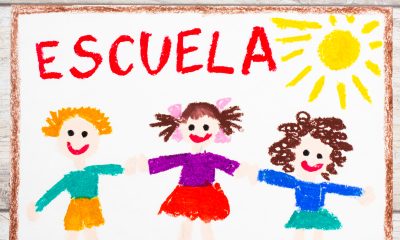Education & Language
Kindergartens in Spain
An Insight into Early Childhood Education
Early childhood education is a critical foundation for lifelong learning and development.
In Spain, kindergartens, known as “educación infantil,” play a vital role in nurturing young minds and preparing them for primary education.
This article explores the structure, curriculum, and cultural aspects of kindergartens in Spain, highlighting the importance placed on early education by Spanish society.
Structure of Early Childhood Education
- Age Groups:
- Educación infantil is divided into two cycles:
- First Cycle: For children aged 0 to 3 years, often referred to as “guarderías” or nurseries.
- Second Cycle: For children aged 3 to 6 years, which is more structured and is part of the formal education system.
- Educación infantil is divided into two cycles:
Types of Kindergartens:
- Public Kindergartens:
Funded by the government and usually free or low-cost for residents.
These are often attached to public primary schools. - Private Kindergartens:
Independently funded and may offer specialized programs, such as bilingual education or Montessori methods.
They generally charge higher fees. - Concertados:
Semi-private institutions that receive partial funding from the government but may also charge fees.
Enrollment:
- Enrollment in the second cycle of educación infantil (ages 3 to 6) is not compulsory but is highly encouraged.
The vast majority of children in Spain attend this cycle, reflecting the value placed on early education.
Curriculum and Educational Approach
- Holistic Development:
- The curriculum in Spanish kindergartens focuses on holistic development, encompassing cognitive, social, emotional, and physical growth.
Activities are designed to promote creativity, critical thinking, and problem-solving skills.
- The curriculum in Spanish kindergartens focuses on holistic development, encompassing cognitive, social, emotional, and physical growth.
- lay-Based Learning:
- Play is central to the educational approach in Spanish kindergartens. Children engage in various activities, such as arts and crafts, music, storytelling,
and outdoor play, which foster learning in a natural and enjoyable manner.
- Play is central to the educational approach in Spanish kindergartens. Children engage in various activities, such as arts and crafts, music, storytelling,
- Language Development:
- Language development is a key focus, with many kindergartens offering bilingual education (Spanish and a regional language like Catalan, Basque, or Galician).
Some private institutions also provide English immersion programs.
- Language development is a key focus, with many kindergartens offering bilingual education (Spanish and a regional language like Catalan, Basque, or Galician).
- Social Skills and Values:
- Emphasis is placed on developing social skills, cooperation, and empathy.
Children are encouraged to interact with peers, share, and work together on group activities.
- Emphasis is placed on developing social skills, cooperation, and empathy.
- Parental Involvement:
- Parental involvement is highly valued in Spanish kindergartens.
Schools often organize workshops, meetings, and activities that involve parents in their children’s education.
- Parental involvement is highly valued in Spanish kindergartens.
Daily Routine and Environment
- Daily Schedule:
- A typical day in a Spanish kindergarten includes a mix of structured activities and free play.
The day usually starts with a morning assembly or circle time, followed by lessons and activities.
There is also time for meals, naps, and outdoor play.
- A typical day in a Spanish kindergarten includes a mix of structured activities and free play.
- Learning Environment:
- The learning environment in Spanish kindergartens is designed to be stimulating and safe.
Classrooms are equipped with age-appropriate educational toys, books, and materials that encourage exploration and discovery.
- The learning environment in Spanish kindergartens is designed to be stimulating and safe.
- Outdoor Activities:
- Outdoor play is an essential part of the daily routine.
Kindergartens often have playgrounds and garden areas where children can engage in physical activities and develop their motor skills.
- Outdoor play is an essential part of the daily routine.
Cultural and Regional Variations
- Regional Languages:
- In regions with distinct languages, such as Catalonia, the Basque Country, and Galicia, kindergartens incorporate regional languages into the curriculum alongside Spanish.
This bilingual approach helps preserve regional identities and promotes linguistic diversity.
- In regions with distinct languages, such as Catalonia, the Basque Country, and Galicia, kindergartens incorporate regional languages into the curriculum alongside Spanish.
- Festivals and Traditions:
- Cultural festivals and traditions are celebrated in kindergartens, providing children with a sense of cultural heritage and community.
Activities related to local festivals, such as making traditional crafts or participating in local dances, are common.
- Cultural festivals and traditions are celebrated in kindergartens, providing children with a sense of cultural heritage and community.
- Nutrition and Meals:
- Nutrition is an important aspect of early childhood education in Spain.
Many kindergartens provide healthy meals and snacks, emphasizing the Mediterranean diet, which includes fresh fruits, vegetables, and whole grains.
- Nutrition is an important aspect of early childhood education in Spain.
Challenges and Improvements
- Access and Availability:
- While the second cycle of educación infantil is widely accessible, availability of spots in public nurseries (first cycle) can be limited, particularly in urban areas.
Efforts are ongoing to expand access and improve facilities.
- While the second cycle of educación infantil is widely accessible, availability of spots in public nurseries (first cycle) can be limited, particularly in urban areas.
- Quality and Standards:
- Ensuring high-quality education across all kindergartens, particularly in private institutions, remains a priority.
The government sets standards and conducts inspections to maintain quality and consistency.
- Ensuring high-quality education across all kindergartens, particularly in private institutions, remains a priority.
- Teacher Training:
- Continuous professional development for early childhood educators is essential.
Initiatives to enhance teacher training and support are crucial for improving educational outcomes.
- Continuous professional development for early childhood educators is essential.
